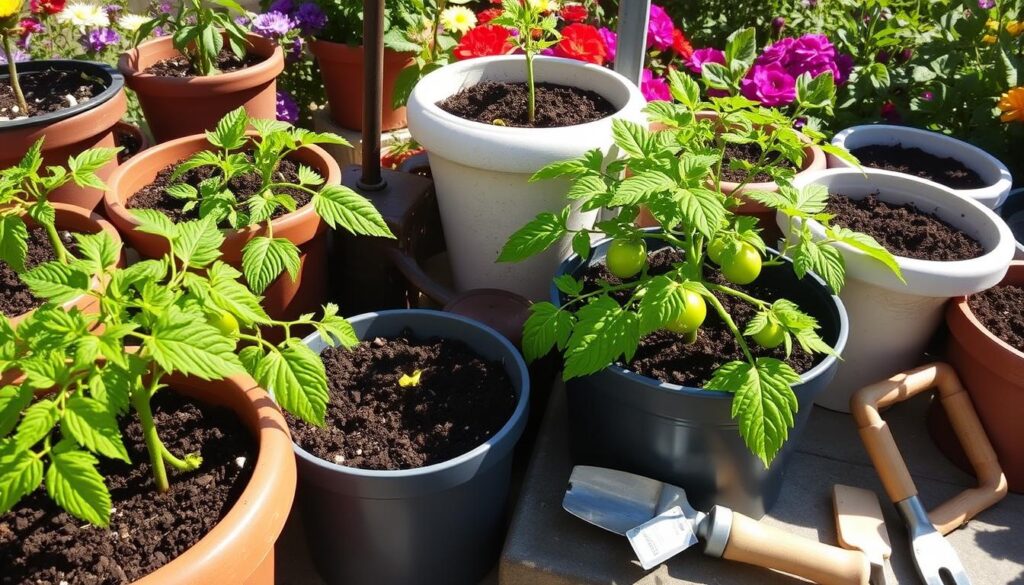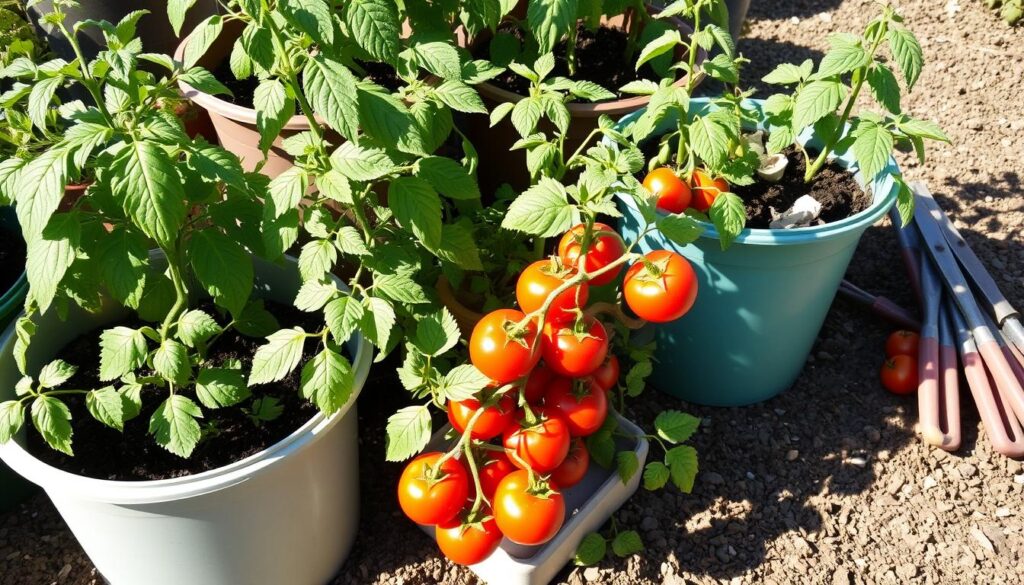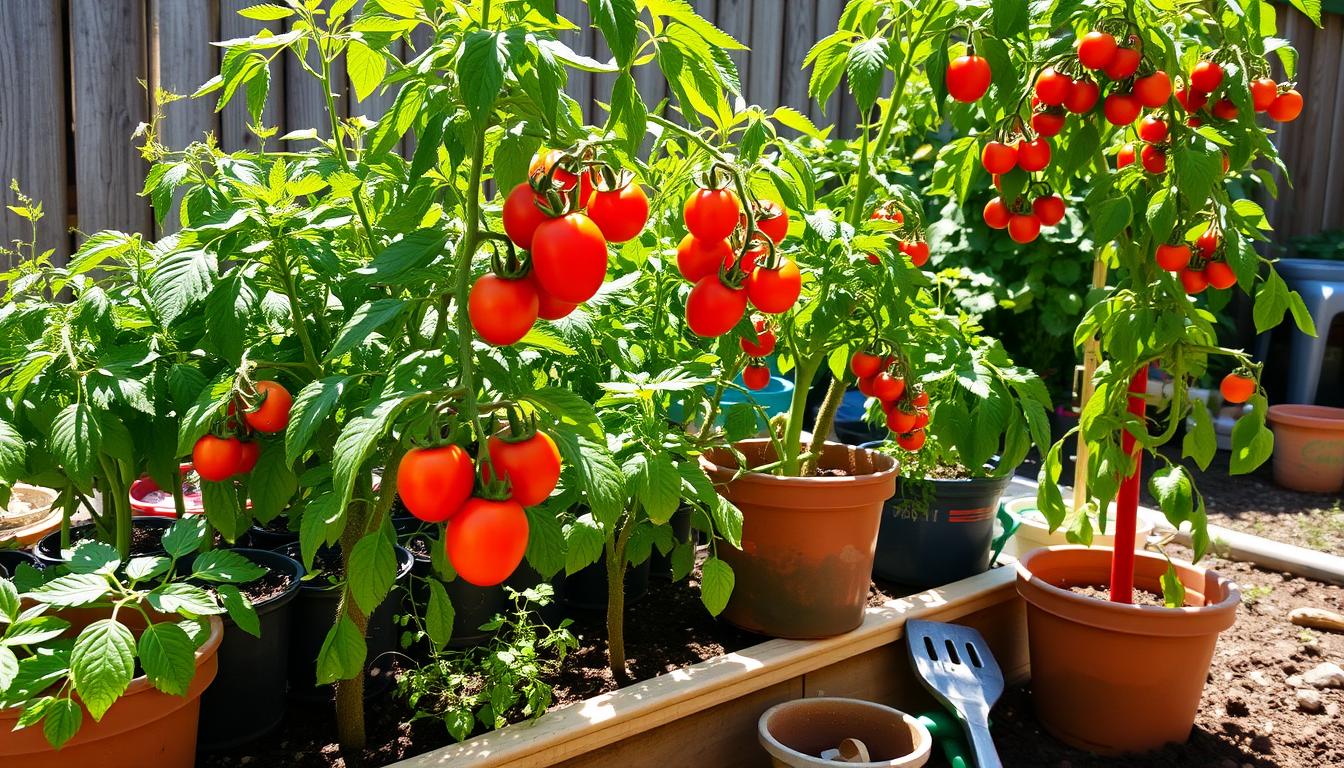Growing tomato plants in containers is great for those with little space or bad soil. It’s perfect for city folks with small balconies or suburban homeowners wanting to grow their own food. With the right spot, container, and soil, you can have delicious homegrown tomatoes, even in tight spaces.
Container gardening lets you control your tomato plants’ environment. It helps protect them from pests, diseases, and bad weather. It’s especially good for those with poor or limited soil. You can use a special potting mix that’s just right for your tomatoes.
Key Takeaways
- Container gardening provides a solution for growing tomatoes in limited or unfavorable spaces
- Properly selecting the container, soil mix, and location is crucial for successful tomato cultivation
- Container-grown tomatoes offer better protection from pests, diseases, and environmental factors
- With the right planning and care, you can enjoy a bountiful harvest of fresh, flavorful tomatoes
- Container gardening allows for greater control and customization of the growing environment
Why Choose Container Gardening for Tomatoes
Container gardening is perfect for city folks, renters, or those with little garden space. It lets you grow tasty tomatoes on your balcony, patio, or sunny windowsill. This way, you can enjoy fresh, homegrown tomatoes, even in small spaces.
Container gardening is super flexible. You can move your tomato plants to get more sunlight. This also helps protect them from pests, bad weather, and other problems.
- Improved soil control: You can pick the perfect soil for your tomatoes in containers. This is great if your garden soil is not good.
- Easier pest management: Keeping your tomatoes in a container makes it easier to spot and deal with pests. This lowers the chance of infestations.
- Versatile placement: You can place your tomato plants to get the most sunlight. This makes the most of your small gardening space.
With the right care, container tomatoes can be as good as those in the ground. Choose the right tomatoes, container size, and soil. Then, you’ll get a big harvest of juicy, tasty tomatoes right on your patio or balcony.
Growing Tomato Plants in Containers: Essential Requirements
To grow tomatoes in containers, knowing what they need is key. Tomato plants do best in certain conditions. This ensures they grow well and produce lots of fruit, whether you’re gardening on a balcony, patio, or small outdoor space.
Sunlight Requirements
Tomato plants need lots of sunlight to grow well. They do best with 6-8 hours of direct sunlight a day. For the best results, place your container in a spot that gets plenty of sun.
Temperature Conditions
Tomatoes love warm weather, between 70-85°F (21-29°C). Keep the temperature in this range to help your plants grow strong and produce lots of fruit. If it gets too hot, use shade cloth or move your containers to a cooler spot.
Space Considerations
The size of your container is very important. Bush-type tomatoes need at least a 10-gallon container, while vining types need 20-gallon or bigger. Make sure to leave 2-3 feet between plants if you have more than one.
By understanding and meeting the essential requirements for growing tomatoes in containers, you can create a thriving and productive tomato garden, even in limited outdoor spaces. With the right combination of sunlight, temperature, and space, you’ll be well on your way to enjoying a bountiful harvest of delicious, homegrown tomatoes.

Selecting the Right Container and Soil Mix
Choosing the right container and soil mix is key for growing tomatoes in containers. Pick containers that are at least 18 inches deep and wide. This gives the roots enough room to grow well. Fabric pots, or grow bags, are great because they help the roots grow in a healthy way.
Plastic pots with holes for drainage work well too. But, don’t use regular garden soil. It’s too heavy and dense for tomatoes. Instead, use a potting mix made for container gardening.
This mix should have compost, coconut coir or peat moss, and perlite or vermiculite. It helps with drainage and air. Adding organic fertilizers like fish meal and bone meal can also help the soil.
- Choose containers at least 18 inches deep and wide for optimal tomato growth.
- Use a high-quality potting mix rather than garden soil for better drainage and aeration.
- Incorporate organic fertilizers like fish meal and bone meal to enrich the soil.
By picking the right container and soil mix, your tomato plants will thrive. They’ll give you a great harvest, even in a small space.

Choosing Tomato Varieties for Container Growing
Choosing the right tomatoes for containers is key to success. Many varieties are great for small spaces and do well in pots. They thrive in the right conditions.
Determinate Varieties
Determinate tomatoes, or “bush” varieties, are perfect for small spaces. They include Glacier, Red Siberian, and Roma types. These plants grow to a certain height and stop, making them great for tight spots.
Indeterminate Varieties
Indeterminate tomatoes grow taller and need more support. But, with the right container and stakes, varieties like Cherokee Purple and Green Zebra can grow well in containers too.
Best Performing Container Tomatoes
Some tomato varieties really shine in containers. Patio, Husky Red, Better Bush, Moby Grape, Totem, Jet Star, Celebrity, and San Marzano are top choices. They grow well, resist diseases, and produce lots of fruit.
| Tomato Variety | Plant Type | Fruit Size | Recommended Container Size |
|---|---|---|---|
| Patio | Dwarf | Medium | 10 inches or larger |
| Husky Red | Dwarf | Cherry | 10 inches or larger |
| Better Bush | Dwarf | Small to Medium | 10 inches or larger |
| Moby Grape | Determinate Grape | Grape | 10 inches or larger |
| Totem | Dwarf | Great | 10 inches or larger |
| Jet Star | Medium | Medium | 12 inches or larger |
| Celebrity | Medium to Large | Medium to Large | 14 inches or larger |
| San Marzano | Determinate | Plum/Sauce | 12 inches or larger |
When picking tomatoes for your container garden, think about fruit size, days to maturity, and disease resistance. This will help you get a great harvest.

Planting and Initial Care Instructions
Planting tomato plants in containers needs the right steps for a good harvest. Start by removing lower leaves and planting the tomato deep. This helps the roots grow strong, which is key for your tomato container hacks.
Before planting, add crushed eggshells or organic fertilizer to the hole. These help your tomatoes get the nutrients they need. After planting, water well to settle the soil and help the roots.
For vertical tomato gardening, set up a strong cage or trellis early. This keeps the plant upright and makes it easier to manage. Mulch the soil with 2-3 inches of organic material to keep it moist and weed-free.
Use a self-watering container or drip irrigation for even moisture. These tomato pruning techniques make watering easier and keep your plants hydrated.

“Proper planting and initial care are crucial for a successful tomato harvest in containers. With the right techniques, you can maximize your yield and enjoy delicious homegrown tomatoes all season long.”
Maintenance and Care Throughout the Growing Season
Keeping your container-grown tomato plants healthy is key to a great harvest. Let’s look at the important steps to keep your tomatoes growing well all season.
Consistent Watering
Tomato plants in containers need regular watering, aiming for 1 inch of water weekly. Check the soil moisture often, especially in fabric pots or when it’s hot and windy, as they may need water twice a day. Right watering helps avoid problems like blossom end rot, caused by uneven moisture.
Fertilizing for Optimal Growth
To feed your container tomatoes well, fertilize them every 2-3 weeks with a balanced, tomato-specific fertilizer. This supports healthy growth and lots of fruit.
Pest and Disease Management
Keep an eye on your tomatoes for pests like aphids and diseases like blight. Use plants like basil or marigolds to keep pests away naturally. Deal with problems quickly to keep your plants healthy.
Pruning and Staking
For indeterminate tomatoes, remove suckers to control growth and focus on fruit. Use tomato cages or trellises for strong support and to make the most of your container space.
Harvesting for Continued Production
Harvest tomatoes regularly as they ripen to keep the plant producing more. This ensures a steady flow of fresh, tasty tomatoes all season.
By sticking to these care tips, your container tomatoes will thrive and give you a big harvest. Adjust your care based on your tomato type and growing conditions for the best results.
Conclusion
Growing tomatoes in containers is a fun and rewarding hobby. By picking the right tomatoes and giving them enough sunlight, you can get lots of fresh tomatoes. Even if you have little outdoor space or live indoors, you can still grow tomatoes.
Try different container sizes, soil mixes, and plants together to get the best results. This way, you can find what works best for your space.
Whether you choose small patio tomatoes or big beefsteak ones, growing them is rewarding. With the right care, your tomatoes will grow well and give you lots of juicy ones. The tips in this guide will help you grow great tomatoes in containers.
Start your container gardening adventure with tomatoes. With a bit of care and creativity, you can enjoy fresh tomatoes from your own place.
FAQ
Q: What are the benefits of growing tomatoes in containers?
A: Container gardening for tomatoes has many perks. It lets you place plants anywhere, even in small spaces. You can control the soil and water better. It’s also easier to manage pests and move plants for more sunlight.
This method is great for city folks, renters, or those with bad garden soil.
Q: How much sunlight and temperature do tomato plants need in containers?
A: Tomatoes need 6-8 hours of direct sunlight a day. More is even better. They do best in temperatures between 70-85°F (21-29°C).
Q: What size containers are best for growing tomatoes?
A: Determinate tomatoes need at least 10-gallon containers. Indeterminate ones need 20-gallon or bigger. Make sure to space plants 2-3 feet apart if using multiple containers.
Q: What type of soil should I use for container-grown tomatoes?
A: Use a high-quality potting mix, not garden soil. This ensures good drainage and aeration. A good mix has compost, coconut coir or peat moss, and perlite or vermiculite.
Add organic fertilizers like fish meal and bone meal to the soil before planting.
Q: What tomato varieties work best for container gardening?
A: Determinate varieties like Glacier, Red Siberian, and Roma are perfect for containers. They’re small and compact. Indeterminate varieties like Cherokee Purple and Green Zebra need bigger containers and support.
Cherry tomato varieties also do well in containers.
Q: How do I care for container-grown tomato plants?
A: Plant tomatoes deep and water them regularly. Fertilize every 2-3 weeks. Prune suckers on indeterminate varieties and watch for pests and diseases.
Use basil or marigolds to keep pests away naturally. Pick tomatoes often to help them keep producing.






